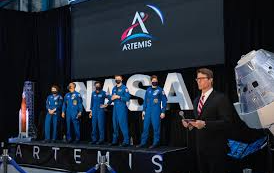
Four astronauts named for Artemis 2 flight, marking humanity’s return to the Moon in over five decades
NASA has unveiled the crew for its Artemis 2 mission, the first to take astronauts around the Moon in more than 50 years. The crew will embark on a 10-day journey, designed to test the systems for the upcoming Artemis missions aimed at landing on the lunar surface and eventually reaching Mars.
The four astronauts selected for the mission are: Christina Hammock Koch, who will serve as the mission specialist and is the first woman to be assigned to a lunar mission; Jeremy Hansen, another mission specialist; Victor Glover, who will be the mission pilot and the first person of colour to fly on such a journey; and Reid Wiseman, the mission commander.
Koch, an experienced astronaut, has set records for the longest continuous time spent in space by a woman and participated in the first all-female spacewalk. The crew was announced by NASA’s head of flight operations, Norman D. Knight, alongside NASA Administrator Bill Nelson, at an event on Monday.
Artemis 2 is scheduled for launch as early as 2024, with the primary goal being to test the Orion spacecraft’s life-support systems and other essential technology in deep space. The mission will take the astronauts about 6,400 miles beyond the Moon, bringing them farther from Earth than any human has been since the Apollo 17 mission in 1972.
The spacecraft will be propelled by NASA’s Space Launch System (SLS) rocket, conducting manual manoeuvres before returning to Earth using the gravitational forces of the Moon and Earth, resulting in a propulsion-free return journey. The mission will culminate in a splashdown in the ocean.
This marks a key milestone in the Artemis programme, which aims to eventually land astronauts on the Moon, including the first woman, and use lunar exploration as a stepping stone for future Mars missions. If Artemis 2 proves successful, the first crewed lunar landing in over 50 years will follow on Artemis 3, with annual crewed missions continuing thereafter.
Artemis distinguishes itself from the Apollo programme by involving commercial space companies, including SpaceX, and international space agencies from Canada, Europe, and Japan. It also signifies a major shift in NASA’s ambitions, focusing on deep space exploration after decades of operations centred around low-Earth orbit.












